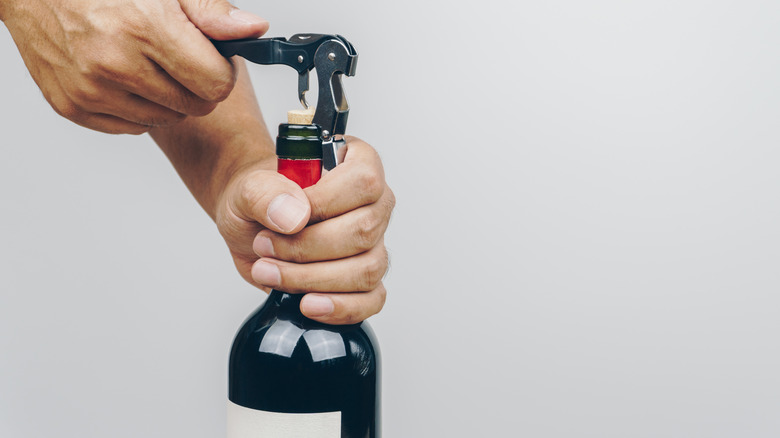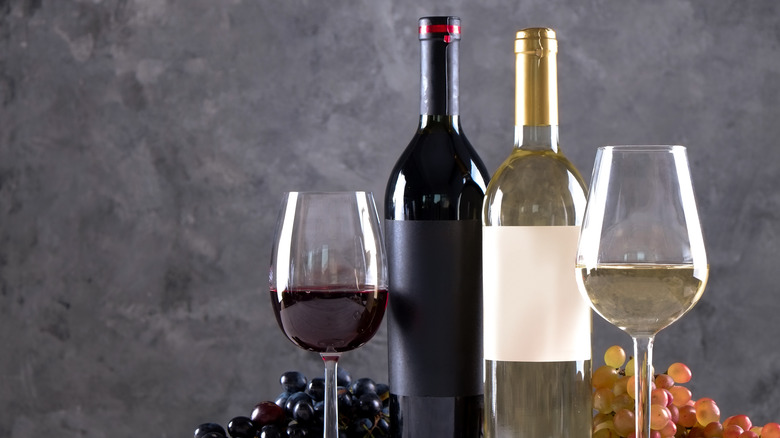The Storage Hack To Save Opened Red Wine
If you've got a lovely bottle of red wine that you want to savor over a few nights (or perhaps you're just not a big drinker), there's a better way to store it than just putting the cork back on or screwing on the cap, and putting it on your shelf. Instead, you want to decant the remaining wine into a smaller bottle.
The goal is that there should be less air in the wine bottle, which means the wine is less likely to oxidize, a chemical process that occurs when the wine is exposed to oxygen, dampening its flavor and aroma. A good approach is to use half-sized wine bottles, which fit around 12 ounces of liquid in them. Most wine stores should sell these smaller bottles, so just drink up that wine and save the bottles for re-use later on. Use a funnel to pour the wine from the full-sized bottle into the half-bottle, and then just cap or cork it and store it somewhere dark and cool (some people also recommend storing opened red wines in the fridge). Of course, you'll want the half bottle to be as clean as possible before you pour the wine in — otherwise, if it has residual traces of a previous wine, those will intermingle and potentially ruin the taste of your leftover wine.
What else to know about decanting
When you decant wine into a smaller bottle, you're not going to totally prevent it from being exposed to oxygen. This isn't really a problem: The goal here is to reduce the exposure to oxygen, not to completely prevent it. So, a little bit of air at the top of a half-bottle is okay, since it's not enough to cause substantial oxidation (as compared to the much larger pocket of air at the top of a half-full big bottle). Just be sure the new bottle is sealed. Some serious wine enthusiasts will even try to vacuum-seal opened bottles to get all air out, or even use gasses like argon to prevent oxidation, although there's some debate about whether these processes (especially the vacuum pumps) really make a difference.
Of course, the half-bottle decanting hack works best if you have half a bottle of wine leftover — it gets tougher if you have say, two-thirds or one-quarter of a bottle left, which won't fit neatly into a 12-ounce half-bottle. You can decant the wine into another bottle that better fits the exact leftover volume, of course. It doesn't even need to be glass — theoretically, you can store wine for the short term in a plastic bottle if it's clean. That said, some experts note that plastic is more porous than glass, so it may oxidize (although this would take months, not days), and more importantly, it could retain flavors from whatever was in the bottle before.
What happens when wine oxidizes, anyway?
When wine is exposed to oxygen over time, it'll undergo chemical changes: This is oxidation. Specifically, the ethanol (that means the alcohol) in the wine will turn into acetaldehyde, a gas that's usually linked with flavors and aromas of nuts, apples, and sherry. Oxidized wine is not all bad: Depending on what's being produced and the aims of the winemaker, some oxidation is actually desirable in order to get a specific profile of flavors or aromas; to speak very generally, sherry is really just a substantially oxidized wine. But too much oxidation is often regarded as a problem, as it causes the brighter, fruitier notes of a wine to dissipate, both in terms of taste and scent (although it's still safe to drink). Oxidized wine is generally described as tasting less flat and vibrant, and it may have a vinegary side to its palate. It also looks different: Oxidized red wines will move towards a more brown-orange tone, while whites will darken in color.
All types of wine will oxidize with exposure to oxygen, not just red wines, so the decanting trick is also useful for whites and rosés. Sparkling wine is a different beast since decanting it will cause the bubbles to evaporate faster, which isn't ideal if you want to store it — and storing opened champagne is sometimes regarded as a bad idea, anyway.


